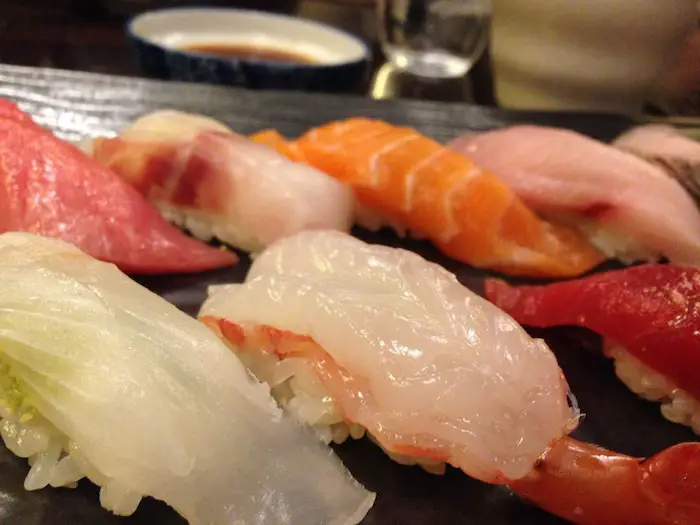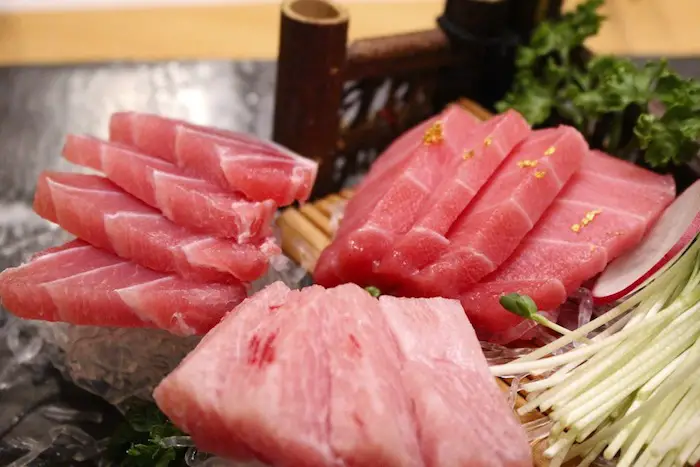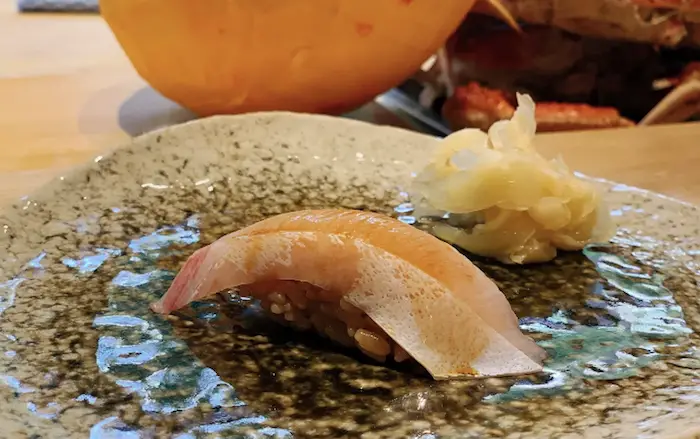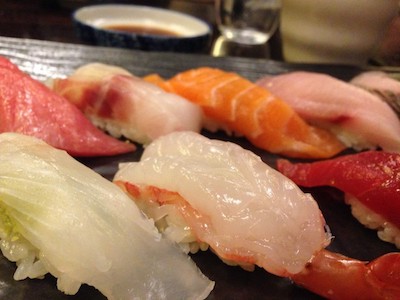We are reader supported. When you purchase through links on our site, we may earn an affiliate commission. Also, as an Amazon affiliate, we earn from qualifying purchases.

Soft, succulent, and savory, the raw fish on sushi may melt into your mouth like butter and leave behind a nice subtle flavor. I have some American friends who were initially scared of eating raw fish and now they are so hooked that they can have it every day. But, is okay to eat a lot of sushi or should you be afraid of infection from parasites.
Can you get worms from sushi? I would say both ‘yes’ and ‘no’. Yes, if you eat sushi containing raw fish that is contaminated with bacteria and worm. No, if you only eat sushi made from sushi-grade raw fish because they are frozen at extremely low temperatures to kill the parasites.
Besides ensuring that you consume only sushi-grade fish, there are several other factors that come into play when determining whether or not you can get sick by eating sushi. Read on to know more.
Contents
Reasons To Get Worms From Sushi

1. Eating sushi at unpopular places
Dining at sketchy or unpopular sushi restaurants increases the possibility of getting sick because such places do not have a lot of customers. Hence, the quality of the raw fish they use is questionable. If the restaurant does not specialize in sushi and it is one of the items on the menu, then also avoid eating there.
I strongly suggest that you only eat at a popular sushi restaurant or the one that maintains an ‘A’ rating consistently because the ratings are based on their refrigeration capacity. Furthermore, if a sushi outlet is popular, the inventory gets finished faster so they will always have sushi-grade fish available.
2. Consuming sushi that has been sitting out
It happens with many of us – we buy things from the grocery store or supermarket but then we forget to take it out of the bag. While other things may not suffer as much in terms of quality, your grocery store-bought sushi roll certainly will.
If you purchased takeaway sushi from a grocery store or supermarket but forgot to eat or store inside the refrigerator once you reached home then chances are that it may be infected with worms. Eating raw fish that has been sitting outside in room temperature for more than 24 hours is an open invitation to food poisoning.
3. Buying raw fish bought from the local fishmonger
Making homemade sushi is fun and you can have a great time trying the different types of sushi recipes in this blog. However, be careful about the source from where you get the raw fish. If you are buying from a local fishmonger, make sure he gives you sushi-grade fish or else you may get sick by eating fish that is not suitable for sushi.
Ask questions to ensure that he understands what is sushi-grade and has a good supply of fish from reliable sources. If you don’t live near the coastal areas, try to find a fishmonger that supplies raw fish to the sushi restaurants in your area.
If you wish to make sushi at home but don’t have a reliable fishmonger or fish market selling sushi-grade fish near you, consider buying online. I prefer getting my raw fish and seafood from Catalina Offshore products for three main reasons – they are safe, they have a good selection of products, and their prices are reasonable.
Types Of Worm Present In Raw Fish
Raw fish, if not processed properly may be hazardous as they may contain worms that get access to the human body. There are typically two types of worms found in raw fish – tapeworms or roundworms. These nasty worms can reside in the intestine or burrow through the blood system and invade other organs of the body, causing sickness.
Tapeworms
Infection caused by tapeworm typically happens when a person accidentally consumes the larvae of diphyllobothrium found in freshwater fish such as trout, perch, pike, and fresh-saltwater fish like salmon.
Wild salmon that has spent a part of its life in freshwater may be a host to Diphyllobothrium tapeworm larvae. Farmed salmon is grown in a controlled environment and they are fed fish food, hence they have a lower risk of carrying worms.
If you ingest tapeworms with your sushi meal by mistake, you may experience symptoms like tiredness, diarrhea, nausea, and weight loss. Thankfully, the discomfort caused by tapeworms can be treated easily with oral medication.
Roundworms
Anisakiasis is the most common type of disease caused by parasitic roundworms found in saltwater fish such as sea bass, cod, plaice, halibut, flounder, rockfish, herring, and Pollock. Raw squid and eel may also carry these worms that can grow up to an inch in length. Symptoms include nausea, vomiting, stomach pain, mild fever, and diarrhea.
The roundworms called nematodes are often referred to as cod worms or herring worms. Different types of species may exist and it’s difficult to distinguish between them but they all belong to the Anisakidae family.
Good Handling Practices And Freezing Methods
The risk of getting worms from sushi can be completely ruled out if the fish is properly handled after it’s caught from the ocean. Freshwater fish are known to have delicate flesh that starts deteriorating as soon as the fish is out of water. Once dead, the flesh deteriorates even faster and if it’s not handled carefully, the worms from the intestines can travel and bury in the flesh.
To prevent this, freshly caught fish is immediately gutted and bled to ensure that is no blood left inside. The fish is then washed in cold water to remove any bacteria and frozen at very low temperatures to keep the quality intact. Following the good handling practices and freezing guidelines laid by the FDA can help minimize the risk of worm infestation.
The commercial freezing of raw fish is done at a temperature of -35°F or below for at least 15 hours to kill any type of parasites that may be present. When frozen at -4°F or below, it may take as much as 7 days to kill worms in large fish. The home freezers usually have temperatures ranging between 0°F and 10°F, thus they are not cold enough to kill parasites.
Flash freezing is the latest technology, an accelerated method wherein the freshly caught fish is immediately frozen in ultra-low temperatures. It is stored at a constant temperature of -10° F without using any artificial preservatives to maintain the look and feel of raw fish.
Safe and Unsafe Fish For Sushi
While the FDA has set specific guidelines for sushi-grade fish, it is unfortunate that there are no strict regulations around it. Even if the fish was properly handled at the point where it was caught, the risk of contamination still remains during its transit, sale, and preparation.
For your sushi to be 100% safe, the raw fish must be correctly frozen from the ship to the chef’s table. Any mistake during the transit or on the part of your fishmonger may make the fish vulnerable to worm infestation. If you are a sushi beginner, here is a list of safe and unsafe fish you must know:
Safe For Consumption

Tuna fish is typically considered safe for raw consumption with a minimal amount of processing because it is highly resistant to worms and other types of parasites. Sushi-grade tuna species such as bigeye, albacore, bluefin, skipjack, bonito, and yellowfin tuna are safe.

Salmon is a popular choice for sushi but make sure you eat only farmed salmon because their wild counterparts spend a significant part of their lives in freshwater, hence they run the risk of being contaminated with parasites.
Tilapia fish has a mild and sweet taste which makes it a great ingredient for sushi. It can also be eaten as sashimi without any health worries. Make sure you buy properly frozen sushi-grade tilapia. It is also safe for pregnant women.

Yellowtail fish, known as hamachi in Japanese is a safe fish for raw consumption. While its considerably resistant to worms, the mercury level may be high. Thus, you must consume hamachi in moderation, especially if you have a compromised digestive system.
Any type of farmed fish has a lower risk of contracting worms as they live in a controlled environment. They are fed fish food to keep them healthy and special care is taken to keep their surroundings clean so that they thrive stress-free.
Unsafe Fish For Consumption
Haddock is a popular fish species found abundantly in summer but you must avoid using this fish for your sushi dinner. The fish is highly susceptible to parasites so it’s essential to cook it in high temperature to kill parasites.
Pollock is another unsafe fish that should not be consumed raw as it may contain a nasty parasite known as cod worms. They are typically large enough to detect with the human eye but it’s better to avoid the risk. I would recommend that you barbeque or grill Pollock if you must use this fish for making sushi.
Largemouth Bass tastes great when they are cooked but you must think twice before incorporating it in your sushi dinner. Raw bass has a high risk of containing parasites so it’s better to avoid this species and choose the safer ones instead.
Keeping Your Sushi Meal Parasite-free

Research well before dining out at a new sushi restaurant and make sure you eat only at a popular place where they serve sushi-grade fish. When in doubt, look for answers to questions like – Do they serve wild or farmed salmon? Do they have a commercial refrigerator with adequate freezing capacity?
Don’t ask a sushi chef whether the fish is fresh or not as this is against the sushi etiquette but you may always ask from where they get their supply. Remember that it’s in the interest of the sushi chef to answer your questions because if customers are not satisfied, they will soon be out of business.
Learn to spot out worms in thin slices of raw fish. They are typically long and thin strands in white, red, pink, or brown color. They will be slowly making movements. If you hold a thin slice of raw meat close to candlelight, you should be able to spot them if there are worms present.
Make sure you are aware of the things to consider when buying sushi-grade fish in the market. You must know where to buy from and signs that tell whether or not the fish is sushi-grade. If you are still unsure, put the frozen fish in your home refrigerator at -4°F for 7 days to kill any worm that may be present.
Remember that all fish out there contain some or the other type of parasites, however only a few make it to the human intestine in unfortunate cases. Other foods also contain bacteria and that’s a certain risk you take while eating out at any restaurant. Raw seafood is best avoided by pregnant women and those who have a compromised immunity system.
5 Tips To Avoid Getting Worms From Sushi
#1. If you bought a grocery store or supermarket sushi, eat it immediately once you take it out of the freezing zone, or else store inside your home fridge. Remember to eat it before the expiry date.
#2. When making sushi at home, make sure you use clean utensils. Wash your hands well and use a disinfect to clean the surface where you work with raw fish.
#3. Limit your raw fish intake because too much of anything is not good for you. If you eat one infected fish, your digestive system may be able to tolerate it but if you eat too many, chances of getting worms are higher.
#4. If you don’t have access to sushi-grade fish in your area, consider making cooked sushi at home. There are many recipes that include grilled or fried fish and they taste equally good.
#5. Always eat sushi at a reputed sushi restaurant and avoid the all-you-can-eat sushi menu at lesser-known places. Ask questions when in doubt and don’t eat anything that doesn’t look or smell right.
Related Questions
Can worms from sushi kill you?
While the worms are not deadly, they can cause a gastrointestinal infection resulting in nausea, upset stomach, and diarrhea. However, these incidences are rare and most of them are reported in Japan. The restaurants in the US mostly use farmed fish so there are fewer cases of food poisoning caused by sushi.
What happens if someone ingests worms by mistake?
If a person eats infected fish, the worm may crawl up to the esophagus (food tube), from where it may be coughed out. In some cases, they may burrow in the stomaching lining causing nausea, pain, and vomiting within 12 hours of eating. If they burrow in the small intestine, they may cause symptoms similar to appendicitis.
Where to buy sushi-grade fish?
You can buy sushi-grade fish from a reputed fishmonger in your area or supermarket where the fish is properly labeled as ‘sushi-grade’. If you don’t have access to these, consider buying frozen fish online from Catalina Offshore Products. I have provided detailed information on these topics in my articles – what is sushi-grade fish and where to buy sushi-grade fish.
According to the Journal of the American Medical Association, listeria is another common disease caused by eating smoked seafood. Hence, pregnant women should avoid it completely.
See Also: Can You Freeze Sushi?
Sources:
https://www.webmd.com/food-recipes/food-poisoning/news/20170512/sushi-lovers-warned-about-parasites
https://www.fda.gov/media/80777/download
https://www.cbsnews.com/news/sushi-parasite-anisakiasis-on-the-rise-doctors-warn
https://www.bbc.com/news/health-39882381
share.upmc.com/2018/03/sushi-safety-risks/
https://healthyeating.sfgate.com/fish-suitable-eating-raw-3206.html


